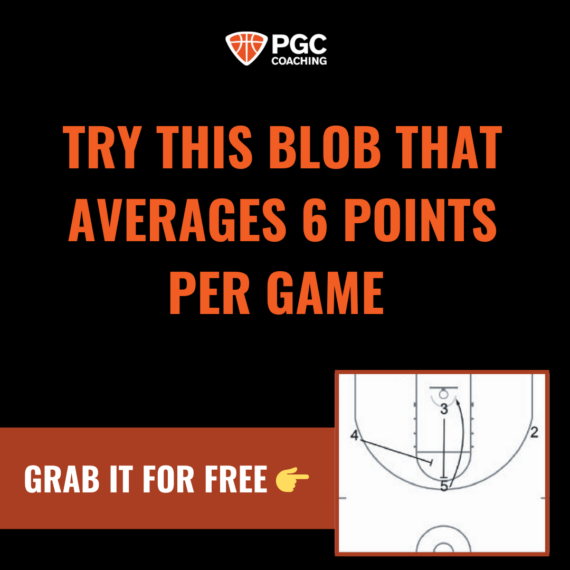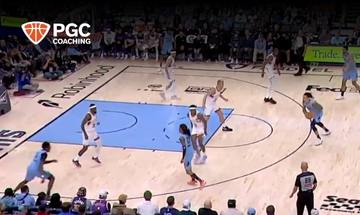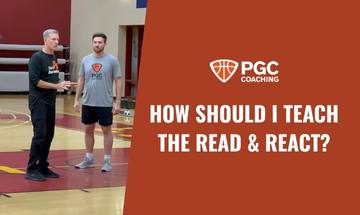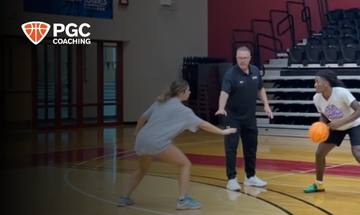Why I Spent 12 Straight Practices on the Read & React (and Didn’t Teach Defense)
A few years ago, at the beginning of the season, I decided to go against just about everything I’d ever done as a coach…
I committed our first 12 practices to one thing: Installing the Read & React Offense.
That’s it. No shell drill, no rotations, no defensive coaching… Just offense.
At this point, you’re likely thinking I’m crazy, but stay with me here because when you’re through reading this, you may be tempted to do the same.
And if you read this and want to explore some other crazy useful ideas, check these out…
- Comfort in Chaos: Train Game-Ready Finishing Under Pressure
- Train the “One Extra” Pass: A Simple Drill to Build Unselfish Teams
- 5 Must-Have Defensive Drills for High-Energy, Game-Ready Teams
- Jump. Mud. Bubble. The 3 Habits Your Defense Is Missing
Why I Made the Decision to Focus Only on the Read & React Offense
This was actually my third time installing the Read & React Offense…
The first time, I followed the system step-by-step, and it led to a national championship.
The second time, I rushed the process. We felt confident and experienced and it came back to bite us in the butt.
The third time, I was going to be intentional. I knew this offense could work for us, but how I installed it would make or break our season.
…So I made a bold choice: 12 straight practices. All offense. No shortcuts. We were going to install the entire Read & React Offense.
What We Focused On
Here’s what our practices looked like:
- Layered learning – We built complexity piece by piece.
- Grouped offensive actions – Ball screens, post entries, basket cuts, etc.
- Inbounds within the system – SOB, BOB, sideline, endline—all framed through Read & React concepts.
- Collapsed time frames – Designed drills to combine execution and game-speed pressure.
- Live defense, no coaching – Created competitive environments without interrupting offensive flow.
It was game-like, without being sloppy.
“But What About Defense?”
I get this question a lot. After all, I used to consider myself a defensive coach.
But the truth is, I probably called myself a defensive coach because I didn’t know how to teach offense well… yet.
So did we ignore defense altogether? Not completely.
We had to use live defense to install our offense correctly, but we didn’t coach it. Instead, we followed two key rules:
- Communicate
- Play your butt off
Here’s What I Learned
Looking back, three lessons stuck with me:
- Offensive clarity builds player confidence. When players know what to do and the why behind it, they play faster, freer, and smarter.
- Limited rules produce toughness. We didn’t coach defense, but we demanded effort, and our players learned to figure it out on their own.
- Time invested early saves time later. Once installed, we ran shell drills with built-in actions, we scouted smarter, and our entire season moved faster because the foundation was strong.
FAQ: Running 12 Straight Practices on the Read & React Offense
Q: Why did you skip coaching defense for 12 practices?
A: The goal wasn’t to ignore defense—it was to maximize offensive clarity during the install of the Read & React system. Live defense was present in every practice to create game-like pressure, but coaching attention was intentionally focused on offensive layering, timing, and decision-making. This helped players build confidence in the offense without being overwhelmed by competing priorities.
Want your team to play with clarity and purpose? Consider an offense-first install window to build foundational fluency.
Q: Isn’t it risky to spend that much time on offense without defensive instruction?
A: It’s a valid concern—but here’s what we saw: effort and communication on defense naturally improved because players were competing live and problem-solving without hand-holding. Once the offense was installed, we layered in defensive systems much faster—and with more context. Long-term, it saved time and improved retention.
Trust the process: front-loading offense can streamline both sides of the ball when implemented strategically.
Q: What if my players struggle with effort or communication on defense?
A: That’s actually one of the benefits of this approach. With minimal coaching rules—“communicate” and “play your butt off”—players learn to take ownership of effort-based habits. Many coaches reported tougher, more vocal teams after this style of install because players had to self-regulate early.
Use limited rules to create accountability—it builds leadership and defensive resilience naturally.
Q: How did you keep practices from becoming sloppy without defense coaching?
A: By designing drills with specific outcomes and decision checkpoints. We used “collapsed time frames” (e.g., 3 passes to score), grouped actions (screens, cuts, entries), and always played at game speed. Live defense added pressure, but the offensive objectives kept things clean and purposeful.
Make your offense live—but limit options or time to maintain focus and execution.
Q: What are the key benefits of installing the entire Read & React Offense upfront?
A: The main benefits are:
- Complete offensive clarity for players
- Better practice flow and contextual decision-making
- Faster integration of defensive schemes later
- Reduced “re-teaching” time throughout the season
It’s like laying the full track before running the train—everything moves more smoothly.
Get ahead of the curve: install offense with intention now, and reclaim practice time later.
Q: Can I apply this approach even if I only have 5 or 6 practices before games?
A: Absolutely. While 12 practices gave us breathing room, even 5–7 offense-only days can produce massive clarity. The key is to layer the most important Read & React actions your team will use most—like drive-and-kick, post entry, and relocation.
Adapt the timeframe to your season—just make it intentional and focused on player clarity.
Q: Does this approach work at the youth or high school level?
A: Yes—maybe even better. Youth and high school players often need more structured reps to develop confidence in timing, spacing, and reads. Installing Read & React early gives them a clear roadmap, which makes skill development and decision-making more efficient.
Use this approach to give young teams a system they can understand—and grow within all season.
Q: How do I transition back to defense after 12 offense-heavy practices?
A: Once the offense is installed, shift to blending offensive actions into defensive shell drills. For example, defend basket cuts, back screens, and post entries using the very actions you drilled on offense. This reinforces both sides of the ball and speeds up teaching.
Make the transition seamless by integrating your offense into your defensive breakdowns.
Q: What if I’m not fully confident in teaching the Read & React system?
A: That’s where tools and community come in. Access to breakdown drills, layer-by-layer video guides, and support through the PGC Coaching Community can make a huge difference. You don’t have to do it alone.
Join our free 7-day trial to access the Read & React install plan and coaching support.
Could This Work for Your Team?
Every team is different, and every coach has to make decisions based on experience, roster, and goals.
But if you’re running the Read & React Offense—or thinking about it—I’d challenge you to ask this question:
Could 5… 7… or even 12 days of all-offense install give your team the jumpstart it needs?
I don’t believe there’s only one right way to build a team. But I do believe this:
The more clarity you give your players, the more confident they’ll be when it counts.
And sometimes, the boldest decision you make… is the one that gets the best results.
Ready to get started?
Installing the Read & React with a bold, offense-first approach isn’t about skipping defense—it’s about building the confidence and clarity your team needs to execute under pressure. If you’re ready to take a strategic leap this season, 5 to 12 practices of pure offense might be exactly what your team needs.
Get 7-day of FREE access to the entire Read & React offense inside our paid PGC Coaching membership.
– TJ
Check more Read & React resources here.
About the Author
TJ Rosene
Coach TJ Rosene, head coach of the Emmanuel University men’s basketball team and Director of Coach Development for PGC Coaching, has spent his career shaping young athletes both on and off the court. With over 400 career wins and 12 seasons of 20+ wins, Rosene’s coaching experience is extensive and impressive. His teams have competed in six national championship games, winning three NCCAA National Championships. Under his leadership, the Lions made their NCAA Division II debut in 2018-19 and quickly captured two season titles and one tournament title, along with an appearance in the NCAA Division II Sweet 16 in 2021.
Rosene’s success expands far beyond the scoreboard. He’s been named National Coach of the Year three times and Conference Carolinas Coach of the Year twice. But for Coach Rosene, the most meaningful part of his work is the lasting impact he has on his players’ lives. As he puts it, “Coaching is a rare opportunity to shape and mold the lives of young people. It’s a privilege that I never take for granted.”
New Here?
Get coaching tips and tools like these delivered to your inbox each week!
Join the 15,000 coaches we’ve assisted…

Related Articles
The Truth About 5 Out (And Every Other Formation in Read & React)
Discover why the Read & React Offense breaks all the rules about spacing and formations — and how motion turns every player into an inside threat. Ready to rethink your offense?
How to Teach the Read & React Offense in 5 Simple Steps
Unlock the Read & React Offense. Learn the simple 5-step plan to build a smarter, faster team. Ready to level up? Get started now!
How to Teach On-Ball Defense That Actually Works in Games
Build lockdown defenders with 5 simple on-ball habits every coach needs to teach. Start winning more defensive battles today!
About PGC
PGC Basketball provides intense, no-nonsense basketball training for players and coaches. Our basketball camps are designed to teach players of all positions to play smart basketball, be coaches on the court, and be leaders in practices, games and in everyday life.
We combine our unique PGC culture with a variety of teaching methods and learning environments to maximize the learning potential of those that attend our sessions. In addition to spending 6-7 hours on the court each day, lessons will be reinforced through classroom sessions and video analysis.
Our goal at PGC is to empower you with the tools to fulfill your basketball dreams, while also assisting you in experiencing the joy of the journey.
To learn more about PGC Basketball, including additional basketball training tips and videos, visit our YouTube Channel or find us on Facebook, Instagram, and Twitter.




Share This Post